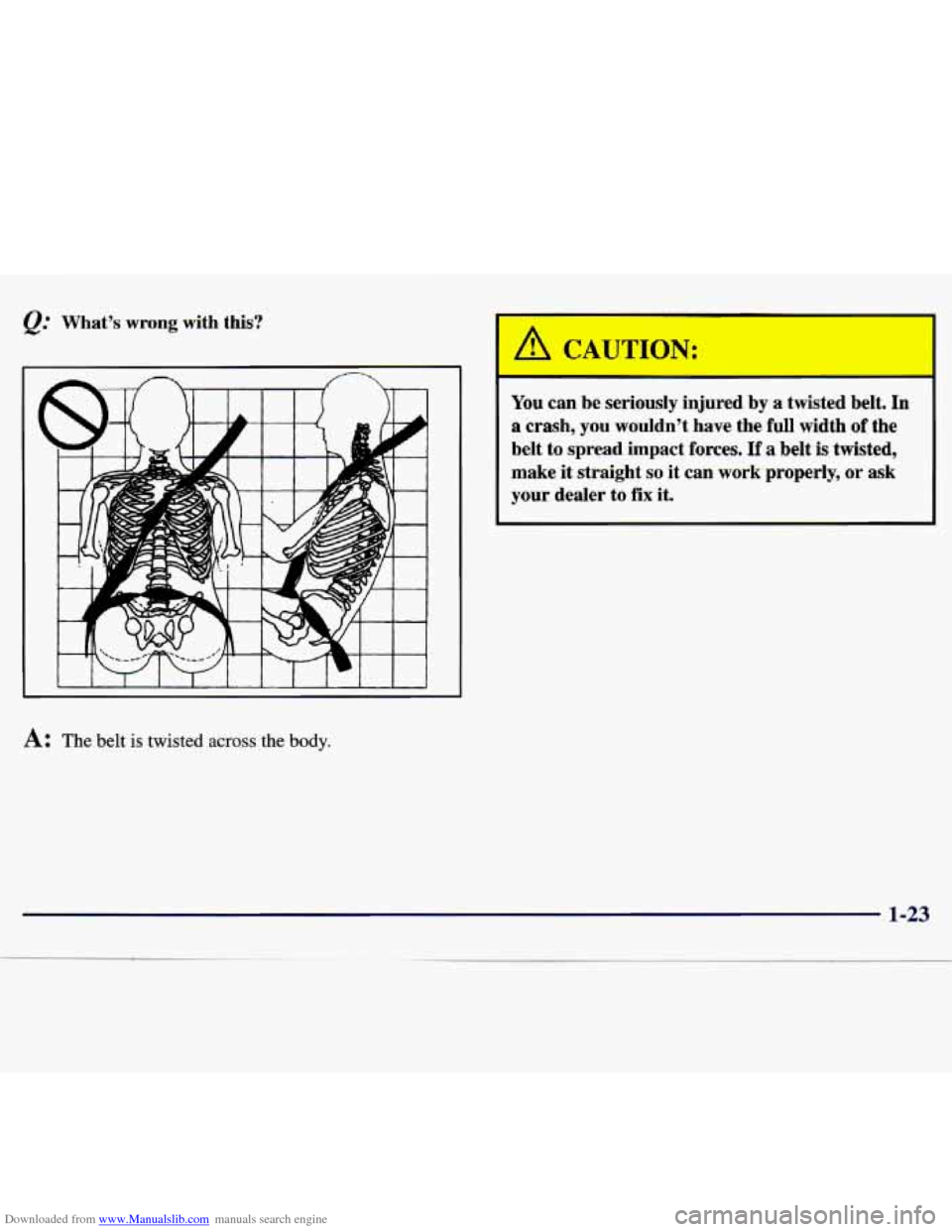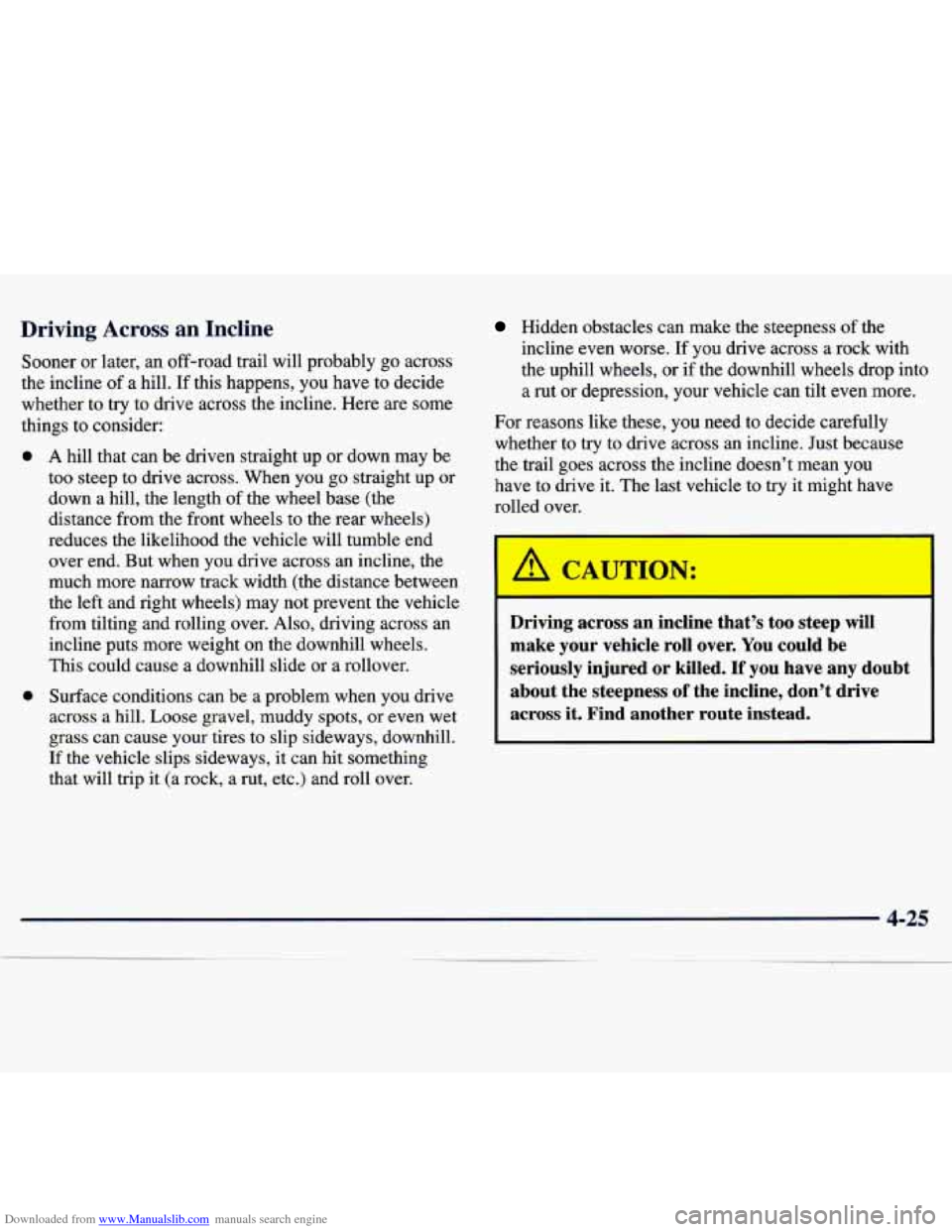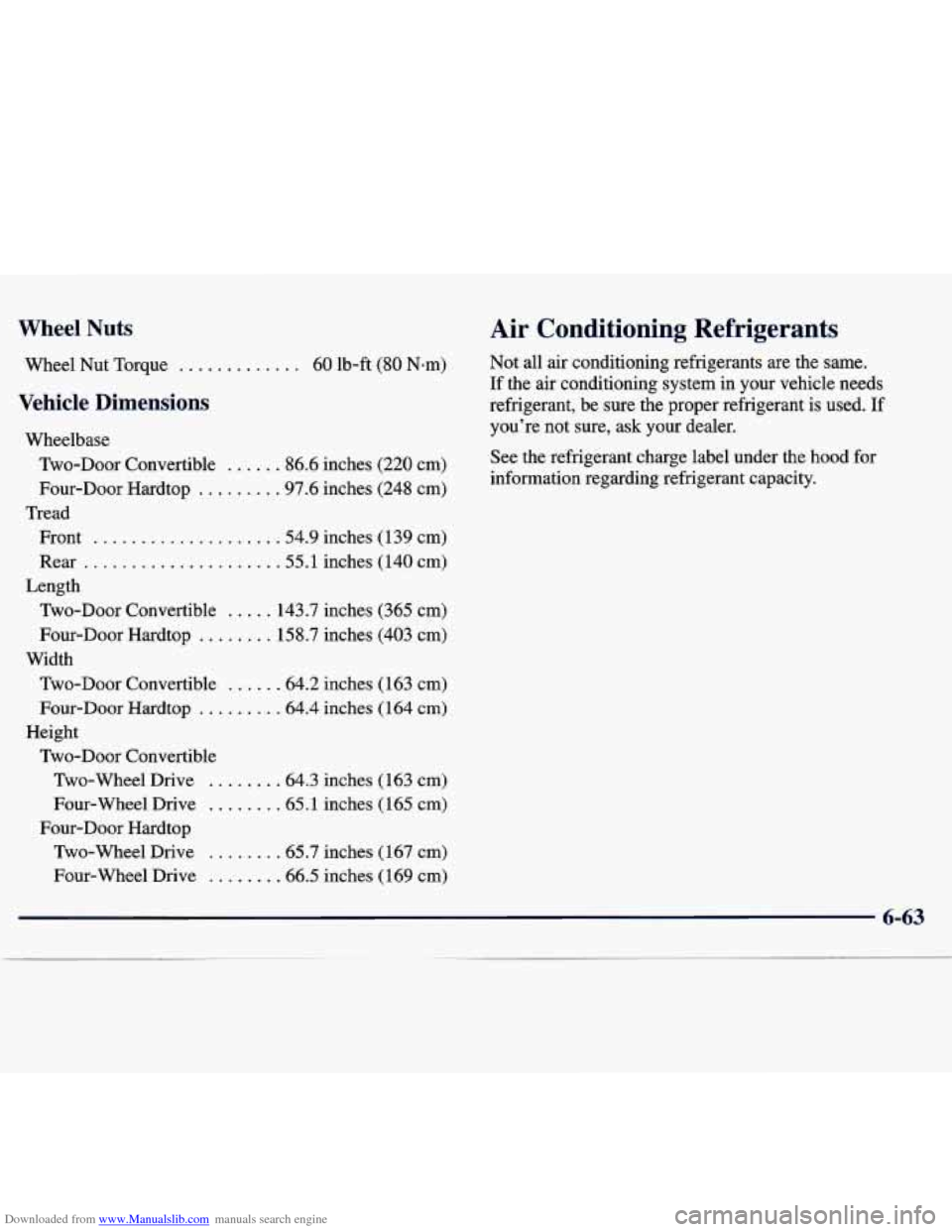width CHEVROLET TRACKER 1998 1.G Owners Manual
[x] Cancel search | Manufacturer: CHEVROLET, Model Year: 1998, Model line: TRACKER, Model: CHEVROLET TRACKER 1998 1.GPages: 386, PDF Size: 21.17 MB
Page 30 of 386

Downloaded from www.Manualslib.com manuals search engine Q: What's wrong with this?
I'
F
You can be seriously injured by a twisted belt. In
a crash, you wouldn't have the full width of the
belt to spread impact forces.
If a belt is twisted,
make it straight
so it can work properly, or ask
your dealer to fix it.
A: The belt is twisted across the body.
1-23
Page 170 of 386

Downloaded from www.Manualslib.com manuals search engine Driving Across an Incline
Sooner or later, an off-road trail will probably go &crW$
the incline of a hill.
If this happens, you have to decide
whether to try to drive across the incline. Here are some
things to consider:
0 A hill that can be driven straight up or down may be
too steep to drive across. When you go straight up or
down a hill, the length of the wheel base (the
distance from the front wheels to the rear wheels)
reduces the likelihood the vehicle will tumble end
over end. But when you drive across an incline, the
much more narrow track width (the distance between
the left and right wheels) may not prevent the vehicle
from tilting and rolling over. Also, driving across an
incline puts more weight on the downhill wheels.
This could cause a downhill slide or a rollover.
0 Surface conditions can be a problem when you drive
across a hill. Loose gravel, muddy spots, or even wet
grass can cause your tires to slip sideways, downhill.
If the vehicle slips sideways,
it can hit something
that will trip
it (a rock, a rut, etc.) and roll over.
Hidden obstacles can make the steepness of the
incline even worse. If
you drive across a rock with
the uphill wheels, or if the downhill wheels drop into
a rut or depression, your vehicle can tilt even more.
For reasons like these, you need to decide carefully
whether to try to drive across an incline. Just because
the trail goes across the incline doesn’t mean you
have to drive it. The last vehicle to try it might have
rolled over.
A CAUTION:
Driving across an incline that’s too steep will
make your vehicle roll over. You could be
seriously injured or killed.
If you have any doubt
about the steepness
of the incline, don’t drive
across it. Find another route instead.
4-25
~ . ~
Page 283 of 386

Downloaded from www.Manualslib.com manuals search engine Temperature -- A, B, C
The temperature grades are A (the highest), B, and C,
representing the tire’s resistance to the generation of
heat and its ability
to dissipate heat when tested under
controlled conditions on a specified indoor laboratory
test wheel. Sustained high temperature can cause the
material of the tire to degenerate and reduce tire life,
and excessive temperature can lead to sudden tire
failure. The grade
C corresponds to a level of
performance which all passenger car tires must meet
under the Federal Motor Vehicle Safety Standard
No. 109. Grades B and A represent higher levels of
performance on the laboratory test wheel than the
minimum required by law.
Warning: The temperature grade for this tire is
established for a tire that is properly inflated and
not overloaded. Excessive speed, underinflation, or
excessive loading, either separately or
in combination,
can cause heat buildup and possible tire failure.
Wheel Alignment and Tire Balance
The wheels on your vehicle were aligned and balanced
carefully at the factory to give you the longest tire life
and best overall performance. Scheduled wheel alignment and wheel balancing are not
needed. However, if you notice unusual tire wear or
your vehicle pulling one way or the other, the alignment
may need to be reset.
If you notice your vehicle
vibrating when driving on a smooth road, your wheels
may need to
be rebalanced.
Wheel Replacement
Replace any wheel that is bent, cracked, or badly rusted
or corroded. If wheel nuts keep coming loose, the wheel,
wheel bolts and wheel nuts should be replaced. If the
wheel leaks air, replace it (except some aluminum
wheels, which can sometimes be repaired). See your
dealer if any of these conditions exist.
Your dealer will know the kind
of wheel you need.
Each new wheel should have the same load-carrying
capacity, diameter, width, offset and be mounted the same way as the one it replaces.
If you need to replace any of your wheels, wheel bolts
or wheel nuts, replace them only with new
GM original
equipment parts. This way, you will be sure to have the
right wheel, wheel bolts and wheel nuts for your
Chevrolet model.
6-46
Page 300 of 386

Downloaded from www.Manualslib.com manuals search engine Wheel Nuts
Wheel Nut Torque ............. 60 lb-ft (80 N-m)
Vehicle Dimensions
Wheelbase Two-Door Convertible
..... -86.6 inches (220 cm)
Four-Door Hardtop
........ .97.6 inches (248 cm)
Tread Front
................... -54.9 inches (1 39 cm)
Rear
.................... .55.1 inches (140 cm)
Two-Door Convertible
..... 143.7 inches (365 cm)
Length
Four-Door Hardtop
........ 158.7 inches (403 cm)
Two-Door Convertible
..... -64.2 inches (163 cm)
Width
Four-Door
Hardtop ........ -64.4 inches (164 cm)
Two-Door Convertible
Height
Two-Wheel Drive
....... .64.3 inches (163 cm)
Four-wheel Drive
....... -65.1 inches (165 cm)
Four-Door Hardtop Two-Wheel Drive
....... .65.7 inches (167 cm)
Four- Wheel Drive
....... .66.5 inches ( 169 cm)
Air Conditioning Refrigerants
Not all air conditioning refrigerants are the same.
If the air conditioning system in your vehicle needs
refrigerant, be sure the proper refrigerant
is used. If
you’re not sure, ask your dealer.
See the refrigerant charge label under the hood for
information regarding refrigerant capacity.